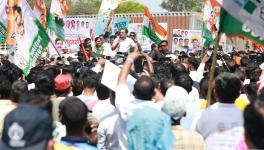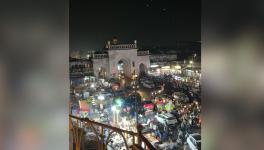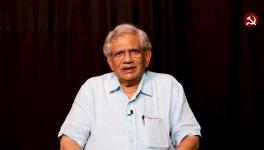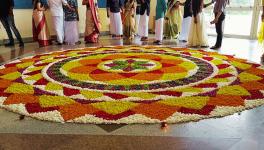Prompted by the Sangh Parivar, UP Thakurs Fighting a Losing Battle Against Dalits
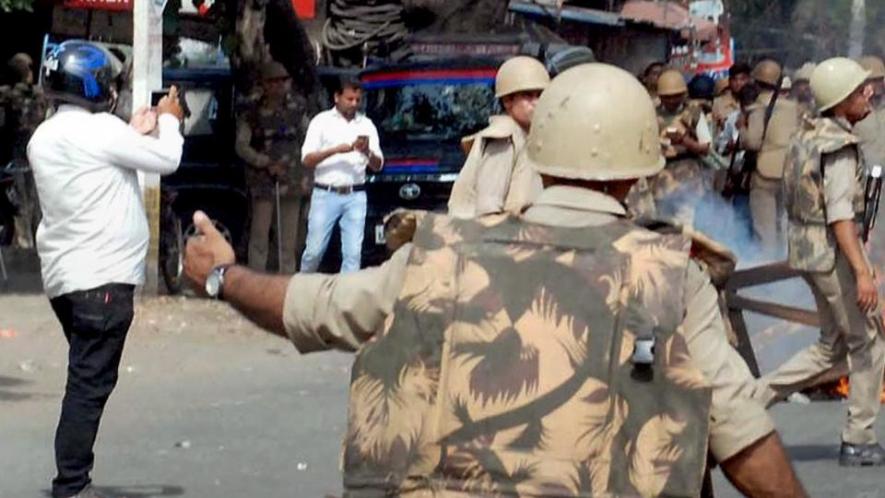
Saharanpur district of Uttar Pradesh has been on the boil for nearly a month as the Thakurs - also known as Kshatriyas or Rajputs - have been engaged in violent attacks on the Dalits in which several people have been killed, several others injured, houses burnt.
Western Uttar Pradesh is a very fertile land owned by powerful farmers from Jat and Gujjar communities who have dominated the politics with late Charan Singh, former Prime Minister of India, the tallest icon among them. Suddenly it is the most active place for the Hindutva strategists to plan their future politics in the state.
The BJP was never the first choice of the farmer communities in Uttar Pradesh. Charan Singh had actually created an alliance of Ahir, Jat, Gujjar and Rajputs (AJGAR). But later on the Janata brand of socialists converted this into MAJGAR by adding Muslims to it. This was a powerful alliance and leaders succeeded through weaving this secular alliance.
Some added ‘Harijans’ too in the combination which was the term being used for Dalits before 1980s. It is another matter that before the arrival of Bahujan Samaj Party (BSP), this region’s Dalits could never use their franchise independently without any fear or favor.
But after the hugely successful ‘Muzaffarnagar experiment’ to control politics in Uttar Pradesh, BJP needed to break this alliance and convert it into the Muslim vs non-Muslim binary which gave it high ‘return’’ of votes during the elections.
An analysis of the beneficiaries from BJP’s strategy and harvest of hatred reveals it is the two communities of Thakurs and Brahmins who were absolutely marginalized in the post-Mandal politics. Due to over-ambitious and narrow-minded approach of current day politicians the dedicated workers of the RSS were able to use the contradiction among various communities to convey to the Thakurs and Brahmins that they were victims of ‘appeasement of Muslims’ and got them highly charged.
The problem with the current dispensation is that it has no time for governance as it continues to be in the election mode having learnt the art of democratic dividends through division of votes.
On April 20th this year, Saharanpur saw an attempt to create a rift between the Dalits and Muslims. BJP MP Ram Lakhan Pal Sharma wanted to celebrate Ambedkar Jayanti by organizing a procession which was to pass through some of the Muslim dominated areas. The administration denied permission as the Dalits who had already celebrated the Ambedkar Jayanti Programme on April 14th felt no need of participating in the BJP-organised programme.
Sharma’s supporters became violent and the police was virtually helpless in front of the goons of the MP. The Superintendent of Police Lav Kumar’s house was ransacked. His wife narrated the ordeal of her family with little children and how they were terrified.
Instead of taking any action against Sharma, the Uttar Pradesh government transferred the honest officer and brought in another officer Subhash Chandra, against whom the previous UP government appointed judicial commission probing Muzaffarnagar riots had passed critical remarks.
The first engineered riots after April 20th was when the Thakurs decided to celebrate the Maharana Pratap Jayanti. Maharana Pratap has become an important icon for the BJP to exploit in the name of ‘nationalism’. But in fact behind celebrations of Maharana Pratap and Prithviraj Chauhan jayantis is the idea of Rajput supremacy.
BJP has been able to use the powerful dominant communities including Rajputs, Jats, Lodhs, Kurmis into its fold through blatant hate propaganda against Muslims. Celebrating these jayantis not only strengthens the perception but also to give an opportunity to the ‘depressed’ communities who do not have any ‘role models’ to propagate. Two prominent Rajput leaders VP Singh and Arjun Singh were widely associated with the movement for social justice for backward classes. But for Rajputs they are ‘traitors’ as they facilitated the implementation of Mandal’s recommendations at different levels.
Recently Yogi Adityanath was invited as chief guest to commemorate the birthday of former Prime Minister Chandrashekhar in Lucknow. Despite claiming to be a ‘socialist’ leader and follower of Acharya Narendra Dev, Chandrashekhar was essentially a Thakur and remained ‘proud’ of his values. In the villages of Uttar Pradesh and Bihar, Thakurs still consider Chandrashekhar as one among their top leaders.
Now, this caste unity is growing beyond party lines. After the ascendency of Yogi Adityanath, the Thakurs in Uttar Pradesh are virtually celebrating. They seem unable to understand the responsibility of running a state administration without any caste biases. There are reports of Thakur civil servants being given important positions in administration.
RSS and other allied organisations are not as active in the state as Yogi Adityanath’s Hindu Yuva Vahini which has outnumbered them. Most of the leaders of the Vahini hail from powerful Rajputs (Thakurs) families as well as dominant OBC communities. This has resulted in violence against Muslims and now against Dalits who are asserting themselves.
Saharanpur has been the hub of the BSP and powerful Ambedkarite assertive politics. The Dalits here have been active in the BSP movement for long and their alliance with Muslims is always a winning combination.
The other powerful community in the district is Gujjar but in the politics of farcical sloganeering the Thakurs and Brahmins have dominated the art of manipulating things. This has reduced Gujjars into a political non-entity despite being in majority in the region.
With elections to the local bodies around the corner, it is reported that BJP’s Raghav Lakhan Pal Sharma is eyeing for his son to contest. However, there is another other side of the story too.
As reported by Sanjiv Chandan in the Forward Press about the possible involvement of Sher Singh Rana, the man accused of killing Samajwadi Party MP Phoolan Devi and who is now on bail. It is no secret that Rana used the murder of Phoolan Devi to promote his political interest by suggesting that he has avenged the killings of the Rajputs in the Behmahi village in Kanpur Dehat allegedly by Phoolan Devi. Sanjiv Chandan, who interviewed him, says that Rana is a politically savvy and highly ambitious person and has been actively promoting Maharana Pratap as the pride of Rajputs.
The rise of Bhim Army can be seen as a threat to Rajput supremacy and there is a possibility of the Hindutva forces supporting such caste army which fights for maintaining status quo.
Prime Minister Narendra Modi has been paying glorious tributes to Dr Baba Saheb Ambedkar. He misses no opportunity to quote him profusely as the builder of modern India. But he has yet to understand that a modern, democratic Ambedkarite cannot go with the old rajas, kings, emperors and monarchs.
Personally speaking, there is no justification of celebrating the valor of rajas and maharajas as they were the product of their period and except for taking pride in their caste, there is nothing much to glorify and celebrate.
Today, if we are talking of ending the caste system, bringing a law against untouchability or affirmative action for the Dalits and other marginalized sections of society, it is because of democracy. Were these possible if we had the old regimes still in place?
Why is Indian society so fanatical about caste and untouchability? If ideologues of the Sangh Parivar who glorify these icons and are deliberately highlighting an icon for each community to celebrate and ‘glory’ over the past, then they should tell us how many of these rajas worked for ending caste discrimination, untouchability in their empire?
In fact the biggest victims of the old system are the Rajputs themselves, where majority of the women still live behind veils (ghoonghat). This is particularly so in Rajasthan which is considered to be a region where Rajputs ruled for long and which still has palaces and forts that make all of us proud of these historical and beautiful structures. But at the same time we have the reality of a highly feudal system, caste system, child marriages and celebration of Sati too. The Sati practice was justified by none less than the Gwalior royal family and one of the founding members of BJP was the late Vijaya Raje Scindia.
The huge protest that the Bhim Army organized at Jantar Mantar last week has shown the strength of the Dalits who may not be willing to depend too much on political parties for resolving their crisis particularly related to their integrity and dignity.
The Bhim Sena has grown in the region by taking up constructive work among in the community, starting schools, developing entrepreneurship among Dalits. Of course, the primary strength of the Bhim Army is the Chamar community. It makes one wonder whether the Hindutva forces see the Bhim Army as a threat or plans to use it to sideline BSP and its leader Mayawati who enjoyed immense power in this region.
People were expecting Bhim Army chief Chandrashekhar Azad to be arrested at the Jantar Mantar. But he has not been arrested so far. At the moment we will not speculate about his activities or future plan of action unless there is some more public action on his part.
On May 23rd, BSP President Mayawati visited Shabbirpur village where the houses of Dalits were ransacked by the Thakurs on May 5th. The administration did not allow her to use a helicopter. Hence she went there by road which proved to be a boon as thousands of BSP workers from Ghaziabad to Meerut and Muzaffarnagar were waiting for her enroute to Saharanpur.
She had a road show and she spoke of maintaining law and order and asked for actions against the culprits. She also provided financial support from her party to families who had lost their houses, which is something the state government should have done.
One may disagree with her but she has been measured in her response which many of her strong critiques in the community see as tame surrender to upper caste politics. But people should not forget that you can’t expect a four-time chief minister to speak in a tit-for-tat, ‘khoon ka badla khoon se lenge’ kind of language which the Hindutva politicians have been using.
Mayawati showed maturity but it is also time for her to aggressively articulate the demands of young educated Dalits who are getting restive with slow or non-responses by her party on these kinds of issues. People feel that she has taken nearly a month to visit Saharanpur yet it warmed the already depressed cadres.
As soon as the Dalits were returning from Mayawati’s programme in Shabbirpur in Saharanpur district, there were clashes and violence was reported. The Thakurs attacked the Dalits resulting in several deaths. It is ironic that the Uttar Pradesh chief minister or the Prime Minister has not spoken a word on the attacks.
Mere condemnation will not work. The fact is that these kinds of contradictions that the BJP tried to manage during the elections with its one-point agenda of anti-Muslim rhetoric will not work for long. The Rajputs have become hyper during this government. Economically, they are not a power house. With land getting fragmented they do not have the strength of numbers to control politics of the region.
In the government services the percentage of Rajputs is very low. One of the reasons for this was the community’s disdain for it given its feudal outlook. Over the past few decades Rajputs did not engage in caste violence and seemed to have accepted the social reality that they don’t have numbers. Nor do they have the financial power of industrialists like Mukesh Ambani to dictate politics to politicians.
But with the growth of Hindutva and its muscular politics, Rajputs are again being ‘militarised’. This is a desperate attempt which is suicidal for it as we are living in the 21st century where each one is being watched and observed. It is the age of human dignity and human rights. In the age of democracy Rajputs can’t live in the present glorying in their ‘past’.
A Maharana Pratap can be an icon for the community in terms of valour. But in today’s world you celebrate it through ideas and not guns. It is time for them to take the path of Buddha and that would guarantee their liberation along with all others.
The creation of community-based heroes is a political construct of the Sangh Parivar so that we all are stuck to our communities and do not accept any other thought of liberation. Such confinement reduces Maharana Pratap to a Rajput icon while relegating Dr Ambedkar to merely a Dalit icon.
The Rajputs and for that matter any other ‘sawarna [upper] caste must liberate itself from the prejudices of the past. That is possible only when they are able to positively understand the writings of Dr Ambedkar. But the political parties which want to use Ambedkar just to garner Dalit votes will never be able to do justice with him.
Dalits are responding to the challenges of the present in different ways. Many believe in a political response, others are thinking of a mighty Bhim Army while a few of them are resorting to religious conversion.
Over 180 families converted to Buddhism in Saharanpur. Earlier, in Sambhal district Balmikis [Valmikis], which is a community of manual scavengers, left Hinduism and embraced Buddhism because of their continuous isolation. The tragedy is that even the barbers were not cutting their hair.
How has it happened that all of a sudden the anti-Dalit feelings in the state are growing? We need to probe it. The fact is that barbers are one of the most humiliated communities in India and at many places their job is not just cutting hair. In our traditional village system of Manu they are supposed to serve both the bride and bridegrooms sides.
This includes washing the feet of baratis and all kind of work which none would advise in modern democratic society. But such is the ‘power’ of varnashram dharma that even a humiliated barber enjoys humiliating those who he feels are ‘lower’ than him.
Long ago Babasaheb Ambedkar had called it graded inequality, ascending order of reverence and descending order of contempt.
Religious conversion definitely has been a liberation theology for the Dalits in India. But pressure of the government makes it difficult for them to exercise this right to faith in today’s time. The right to faith is frankly provided to them just for conversion to Buddhism as the Hindutva forces consider Buddhism part of their dharma. Though this is incorrect they don’t feel too much of threat from it.
Other than this, any conversion to Islam or Christianity by the Dalits will not only be violently protested by the Sangh Parivar’s various offshoots but also by the state apparatus. Even when the Sangh Parivar is not seeing Buddhism as a threat at a broader level they are gleeful of the fact that there has not been any major call for conversion to Buddhism since the passing away of Dr Babasaheb Ambedkar who embraced Buddhism in Nagpur on October 14th, 1956 with a large number of his followers.
Can any organization give a call to Dalits over the country to embrace Buddhism on October 14th 2017 this year? When political parties fail Dalits, they will either embrace militancy or spiritual liberation through conversion. Is there any other way which can give them justice and sense of belonging?
Disclaimer: The views expressed here are the author's personal views, and do not necessarily represent the views of Newsclick.
Get the latest reports & analysis with people's perspective on Protests, movements & deep analytical videos, discussions of the current affairs in your Telegram app. Subscribe to NewsClick's Telegram channel & get Real-Time updates on stories, as they get published on our website.











